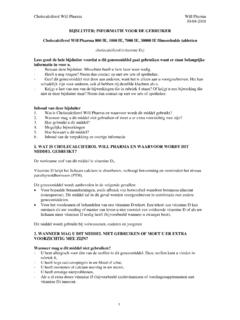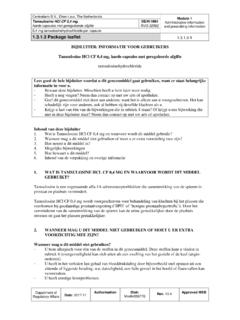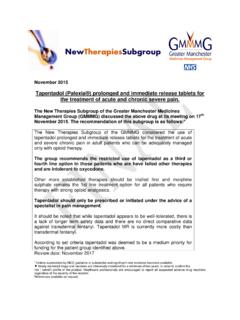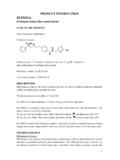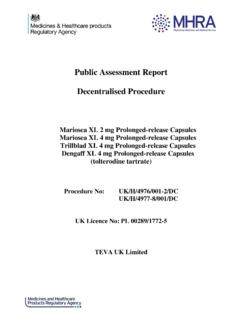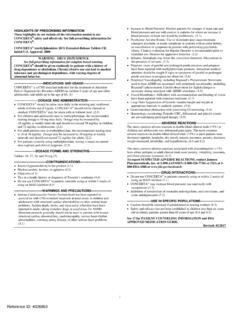Transcription of SUMMARY OF PRODUCT CHARACTERISTICS 1. NAME OF …
1 SUMMARY OF PRODUCT CHARACTERISTICS 1. NAME OF THE MEDICINAL PRODUCT Valproate chrono 300 mg prolonged - release tablets Valproate chrono 500 mg prolonged - release tablets 2. QUALITATIVE AND QUANTITATIVE COMPOSITION Valproate chrono 300 mg prolonged - release tablets One prolonged - release tablet contains 200 mg sodium valproate and 87 mg valproic acid, together equivalent to 300 mg sodium valproate Excipients: 28 mg sodium Valproate chrono 500 mg prolonged - release tablets One prolonged - release tablet contains 333 mg sodium valproate and 145 mg valproic acid, together equivalent to 500 mg sodium valproate Excipients: 47 mg sodium For a full list of excipients, see section 3.
2 PHARMACEUTICAL FORM prolonged - release tablet: White, oblong prolonged - release tablet, with a score line The tablets can be divided into equal halves. 4. CLINICAL PARTICULARS Therapeutic indications Primary form of generalized epilepsy - typical and atypical absences (petit mal) - myoclonic seizures - tonic-clonic seizures (grand mal) - mixed forms of tonic-clonic seizures and absences - atonic seizures May also be used for manifestations of epilepsy that do not adequately respond to other antiepileptic agents, such as: Partial epilepsy - both with elemental (focal) and complex (psychomotor) symptoms.
3 - Secondary forms of generalized epilepsy,especially akinetic and atonic seizures. Monotherapy is often possible in the primary form of generalized epilepsy. In partial epilepsy combined therapy will have to be instituted more frequently, likewise in the secondary form of generalized epilepsy and in mixed forms of primary generalized and partial epilepsy Posology and method of administration The effective dose and duration of this long-term therapy has to be determined individually with the aim beeing free from seizures with the minimum dosage, particularly during pregnancy.
4 Monitoring of the patients is recommended during the period of dose a good correlation between daily dose, plasma level and therapeutic effect has not been demonstrated, generally a plasma level between 40 and 100 micrograms per ml (300-700 micromol/l) sodium valproate is attempted to be obtained. Nevertheless, favourable results with a lower or higher level have not been excluded, especially in children. In cases of dosages of 35 mg sodium valproate/kg bodyweight per day or more, it is advisable to monitor the plasma level.
5 In some cases the full treatment response is achieved after 4-6 weeks. The daily doses should therefore not be increased too early beyond mean values. A maximum daily dose of 60 mg sodium valproate/kg/day should not be exceeded. When changing from pretreatment with (immediate release ) pharmaceutical forms to Valproate chrono 300/500 mg prolonged - release tablets , it must be ensured, that adequate serum levels are maintained. In general, the following dosage regimen may be used: Monotherapy Initial dose: Adults and children Initially 10 -15 mg sodium valproate/kg bodyweight per day is taken in two or more doses during meals; increase the dose weekly in steps of 5-10 mg sodium valproate/kg bodyweight per day until the desired therapeutic effect is achieved.
6 Maintenance dose: As average 20-30 mg sodium valproate/kg bodyweight per day is taken ranging as follows: Adults : 9-35 mg sodium valproate/kg bodyweight per day Children : 15-60 mg sodium valproate/kg bodyweight per day The optimal daily maintenance dose is usually divided into 1 to 2 doses during meals. Children under 20 kg bodyweight: An alternative formulation of valproate should be used in this group of patients, due to the need for dose titration. Elderly The pharmacokinetics of valproate may be altered in the elderly.
7 Dosage should be determined by seizure control. (See section ). The following average daily doses for sodium valproate are recommended (table for orientation purposes): Age Body weight (kg) Average dose (mg/day) 3 - 6 months - 150 6 - 12 months - 10 150 - 300 1 - 3 years 10 - 15 300 - 450 3 - 6 years 15 - 20 450 - 600 7 - 11 years 20 - 40 600 - 1200 12 - 17 years 40 - 60 1000 - 1500 Adults and elderly 60 1200 - 2100 Use in renal impairment: A dose reduction might be necessary in patients with renal impairment due to a possible increase in the level of free valproic acid in serum (see sections and ).
8 Exact calculation of the dosage in mg/kg bodyweight is not strictly necessary. In some patients on lower doses, the daily dose may even be given in one administration, provided that this is well tolerated. Combined therapy If Valproate chrono 300/500 mg prolonged - release tablets are administered in combination with or as substitution therapy for previous medicinal products, it should be considered to reduce the dosage or the previously ordinated medicinal PRODUCT (especially phenoparbitone) in order to avoid undesirable effects (see section ) If the previous medicinal PRODUCT is discontinued, this must be done gradually.
9 As the enzyme-inducing effect of other antiepileptics such as phenobarbitone, phenytoin, primidone and carbamazepine is reversible, the serum level of valproic acid should be measured approximately 4-6 weeks after the last intake of such an antiepileptic and the daily dose reduced if necessary. Method of administrationThe tablets - or half tablets if required - should be taken with a glass of plain water (carbonated drinks should not be used) and swallowed without chewing. If at the start or during treatment gastrointestinal irritation occurs, the tablets should be taken with or after food.
10 Contraindications hypersensitivity to sodium valproate, valproic acid or any of the excipients - hepatic and/or pancreatic impairment - personal or family history of severe hepatic dysfunction, especially drug related. - hepatic porphyria - haemorrhagic diathesis Special warnings and precautions for use Haematological Monitoring of the blood count, including platelet count, bleeding time and coagulation tests, is advisable prior to initiation of therapy and before a surgical or dental operation, and in cases of spontaneous haematomas or bleeding (see section ).





